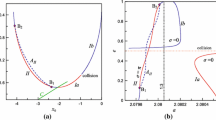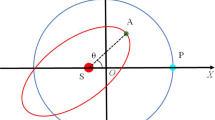Abstract
Zeipel–Lidov–Kozai cycles is the name given to long-term interrelated changes in the inclinations and eccentricities of the orbits of natural and artificial celestial bodies. They were discovered independently by H. von Zeipel (1910), M. Lidov (1961), and Y. Kozai (1962). Originally, the existence of Zeipel–Lidov–Kozai cycles was established for nonresonant motions of celestial bodies. Approaches to studying such secular effects in the case of resonance of orbital movements appeared much later. It turned out that, at resonance, the Zeipel–Lidov–Kozai cycles may not have the symmetry that these cycles always have in nonresonant situations within the framework of the restricted three-body problem. Moreover, results of numerical studies indicate the presence of asymmetric Zeipel–Lidov–Kozai cycles in the dynamics of a number of Kuiper belt objects moving in resonance with Neptune.




Similar content being viewed by others
REFERENCES
von Zeipel, H., Sur l’application des sèries de M. Lindstedt à l'étude du mouvement des comètes périodiques, Astron. Nachr., 1910, vol. 183, pp. 345–418.
Ito, T. and Ohtsuka, K., The Lidov–Kozai Oscillation and Hugo von Zeipel. Monogr. Environ. Earth Planets, 2019, vol. 7, no. 1, pp. 1–113.
Lidov, M.L., Evolution of orbits of artificial satellites of planets under the action of gravitational perturbations of external bodies, Iskusstv. Sputniki Zemli, 1961, no. 8, pp. 5–45.
Kozai, Y., Secular perturbations of asteroids with high inclinations and eccentricities, Astron. J., 1962, vol. 67, pp. 591–598.
Vashkov’yak, M.A., Orbit evolution in the limited circular twice averaged three-body problem, Kosm. Issled., 1981, vol. 19, no. 1, pp. 5–18.
Wisdom, J., A perturbative treatment of motion near 3/1 commensurability, Icarus, 1985, vol. 63, pp. 272–289.
Gallardo, T., Hugo, G., and Pais, P., Survey of Kozai dynamics beyond Neptune, Icarus, 2012, vol. 220, pp. 392–403.
Šidlichovský, M., A non-planar circular model for the 4/7 resonance, Celestial Mech. Dyn. Astron., 2005, vol. 93, pp. 167–185.
Saillenfest, M., Fouchard, M., Tommei, G., et al., Long-term dynamics beyond Neptune: Secular models to study the regular motions, Celestial Mech. Dyn. Astron-., 2016, vol. 126, pp. 369–403.
Murray, C. and Dermott, S., Solar System Dynamics, Cambridge: Cambridge Univ. Press, 1999; Moscow: Fizmatlit, 2009.
Morbidelli, A., Modern Celestial Mechanics. Aspects of Solar System Dynamics, London: Taylor and Francis, 2002; Moscow: IKI RAN, 2014.
Morbidelli, A., Levinson, H.F., and Gomes, R., The dynamical structure of the Kuiper belt and its primordial origin, in: The Solar System Beyond Neptune, Barucci, M.A., Cruikshank, D.P., and Morbidelli, A., Eds., Tucson: Univ. of Arizona Press, 2008, pp. 275–292.
Shevchenko, I.I., The Lidov–Kozai Effect – Applications in Exoplanet Research and Dynamical Astronomy, Springer, 2017.
Sidorenko, V.V., Neishtadt, A.I., Artemyev, A.V., et al., Quasi-satellite orbits in the general context of dynamics in the 1 : 1 mean motion resonance. Perturbative treatment, Celestial Mech. Dyn. Astron., 2014, vol. 120, pp. 131–162.
Beaugé, C., Asymmetric librations in exterior resonances, Celestial Mech. Dyn. Astron., 1994, vol. 60, pp. 225–248.
Chambers, J.E., A hybrid symplectic integrator that permits close encounters between massive bodies, Mon. Not. R. Astron. Soc., 1999, vol. 304, pp. 793–799.
Kankiewicz, P. and Wlodarczyk, I., Dynamical lifetimes of asteroids in retrograde orbits, Mon. Not. R. Ast-ron. Soc., 2017, vol. 468, pp. 4143–4150.
Li, M., Huang, Y., and Gong, S., Survey of asteroids in retrograde mean motion resonances with planets, Astro-n. Astrophys., 2019, vol. 630, id A60.
Wiegert, P., Connors, M., and Veillet, C., A retrograde co-orbital asteroid of Jupiter, Nature, 2017, vol. 543, pp. 687–689.
Sidorenko, V.V., Neishtadt, A.I., Artemyev, A.V., and Zelenyi, L.M., Quasi-satellite regime of motion of small celestial bodies: Formation and destruction, Dokl. Phys., 2013, vol. 58, no. 5, pp. 207–211.
Saillenfest, M. and Lari, G., The long-term evolution of known resonant trans-Neptunian objects, Astron. Astrophys., 2017, vol. 603, id A79.
Sidorenko, V.V., Evolution of asteroid orbits at the 3:1 their mean motion resonance with Jupiter (planar problem), Cosmic Res., 2006, vol. 44, no. 5, pp. 440–455.
Sidorenko, V.V., Dynamics of “jumping” Trojans: a perturbative treatment, Celestial Mech. Dyn. Astron., 2018, vol. 130, no. 10, id 67.
Author information
Authors and Affiliations
Corresponding author
Rights and permissions
About this article
Cite this article
Efimov, S.S., Sidorenko, V.V. On Asymmetric Zeipel–Lidov–Kozai Cycles in Mean Motion Resonances. Cosmic Res 58, 249–255 (2020). https://doi.org/10.1134/S0010952520040097
Received:
Revised:
Accepted:
Published:
Issue Date:
DOI: https://doi.org/10.1134/S0010952520040097




